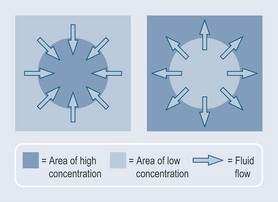Chapter 16 How do drugs get into cells?
Absorption at the Cellular Level
• Cell membranes are effectively selective biological barriers that inhibit the passage of certain molecules.
• Globular proteins – of varying size and make-up – are embedded within the membrane. These tend to be for transport and regulatory functions.
Drugs or remedies cross cell membranes by the following methods:
Passive Diffusion (Absorption)
• Transfer occurs down a chemical gradient; in other words, chemicals move from an area of high concentration to an area of low concentration (osmosis) (Figure 16.1); This can be from the gastrointestinal tract to the bloodstream, where the concentration of the substance is lower.
• Chemicals absorbed this way tend to be fat soluble and non-polar, features that allow them to pass across the phospholipid membrane. Some polar molecules can pass through but they must be very small.
• Small molecules will penetrate the membrane more easily, and therefore more rapidly, than a large molecule.
• Because there is rapid removal of substrates due to the circulation flowing rapidly past the site, absorbed chemicals become distributed over a wide area of the body.
As the pH varies through the digestive tract, so do the characteristic of many compounds (see Chapter 8 ‘Acids and bases’, p. 55). This leads to certain compounds being more non-polar than others. This then affects how easily they can pass through the membrane. The condition of the digestive tract is therefore an important factor in chemical absorption.
Facilitated Passive Diffusion
• There is possibly some type of carrier that combines reversibly with the molecules on one side of the membrane and transfers them over to the other side. Such carriers are specific for certain molecules.
• The whole process is limited by the number of carriers present, so it is possible for the system to reach saturation, at which point it will be unable to work any faster.
Stay updated, free articles. Join our Telegram channel

Full access? Get Clinical Tree



